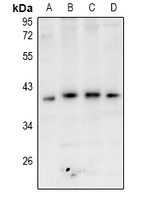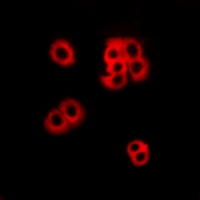Anti-GPR174 Antibody
Rabbit polyclonal antibody to GPR174
- SPECIFICATION
- CITATIONS
- PROTOCOLS
- BACKGROUND

Application
| WB, IF/IC |
|---|---|
| Primary Accession | Q9BXC1 |
| Other Accession | Q3U507 |
| Reactivity | Human, Mouse, Rat |
| Host | Rabbit |
| Clonality | Polyclonal |
| Calculated MW | 38503 Da |
| Gene ID | 84636 |
|---|---|
| Other Names | Probable G-protein coupled receptor 174 |
| Target/Specificity | KLH-conjugated synthetic peptide encompassing a sequence within the center region of human GPR174. The exact sequence is proprietary. |
| Dilution | WB~~WB (1/500 - 1/1000), IF/IC (1/100 - 1/500) IF/IC~~N/A |
| Format | Liquid in 0.42% Potassium phosphate, 0.87% Sodium chloride, pH 7.3, 30% glycerol, and 0.09% (W/V) sodium azide. |
| Storage | Store at -20 °C.Stable for 12 months from date of receipt |
| Name | GPR174 |
|---|---|
| Function | G-protein-coupled receptor of lysophosphatidylserine (LysoPS) that plays different roles in immune response (PubMed:36823105). Plays a negative role in regulatory T-cell accumulation and homeostasis. Under inflammatory conditions where LysoPS production increases, contributes to the down-regulation of regulatory T-cell activity to favor effector response. Mediates the suppression of IL-2 production in activated T-lymphocytes leading to inhibition of growth, proliferation and differentiation of T-cells. Mechanistically, acts via G(s)- containing heterotrimeric G proteins to trigger elevated cyclic AMP levels and protein kinase A/PKA activity, which may in turn act to antagonize proximal TCR signaling. Plays an important role in the initial period of sepsis through the regulation of macrophage polarization and pro- and anti-inflammatory cytokine secretions. Upon testosterone treatment, acts as a receptor for CCL21 and subsequently triggers through G(q)-alpha and G(12)/G(13) proteins a calcium flux leading to chemotactic effects on activated B-cells. Signals via GNA13 and PKA to promote CD86 up-regulation by follicular B-cells. |
| Cellular Location | Cell membrane; Multi-pass membrane protein. |

Thousands of laboratories across the world have published research that depended on the performance of antibodies from Abcepta to advance their research. Check out links to articles that cite our products in major peer-reviewed journals, organized by research category.
info@abcepta.com, and receive a free "I Love Antibodies" mug.
Provided below are standard protocols that you may find useful for product applications.
Background
KLH-conjugated synthetic peptide encompassing a sequence within the center region of human GPR174. The exact sequence is proprietary.
If you have used an Abcepta product and would like to share how it has performed, please click on the "Submit Review" button and provide the requested information. Our staff will examine and post your review and contact you if needed.
If you have any additional inquiries please email technical services at tech@abcepta.com.













 Foundational characteristics of cancer include proliferation, angiogenesis, migration, evasion of apoptosis, and cellular immortality. Find key markers for these cellular processes and antibodies to detect them.
Foundational characteristics of cancer include proliferation, angiogenesis, migration, evasion of apoptosis, and cellular immortality. Find key markers for these cellular processes and antibodies to detect them. The SUMOplot™ Analysis Program predicts and scores sumoylation sites in your protein. SUMOylation is a post-translational modification involved in various cellular processes, such as nuclear-cytosolic transport, transcriptional regulation, apoptosis, protein stability, response to stress, and progression through the cell cycle.
The SUMOplot™ Analysis Program predicts and scores sumoylation sites in your protein. SUMOylation is a post-translational modification involved in various cellular processes, such as nuclear-cytosolic transport, transcriptional regulation, apoptosis, protein stability, response to stress, and progression through the cell cycle. The Autophagy Receptor Motif Plotter predicts and scores autophagy receptor binding sites in your protein. Identifying proteins connected to this pathway is critical to understanding the role of autophagy in physiological as well as pathological processes such as development, differentiation, neurodegenerative diseases, stress, infection, and cancer.
The Autophagy Receptor Motif Plotter predicts and scores autophagy receptor binding sites in your protein. Identifying proteins connected to this pathway is critical to understanding the role of autophagy in physiological as well as pathological processes such as development, differentiation, neurodegenerative diseases, stress, infection, and cancer.



